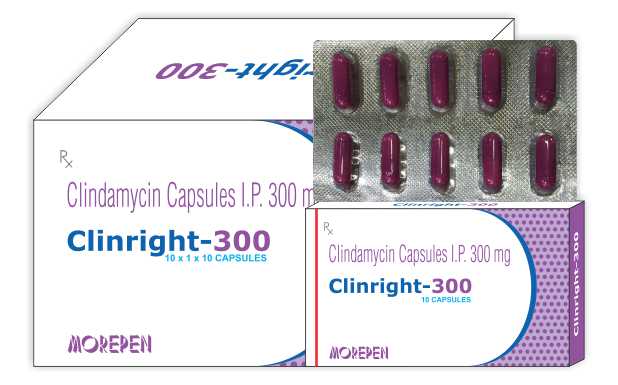Capsule Presentation
Each Capsule Contains:Clindamycin Hydrochloride IP eq. to clindamycin 300 mg
Clindamycin is a semi-synthetic lincosamide antibiotic used in the treatment of a variety of serious infections due to susceptible microorganisms. It has a relatively narrow spectrum of activity that includes anaerobic bacteria as well as gram-positive cocci and bacilli and gram-negative bacilli.8 Interestingly, clindamycin appears to carry some activity against protozoans, and has been used off-label in the treatment of toxoplasmosis, malaria, and babesiosis.
Indications
- Abscess, Intra-Abdominal caused by Anaerobic Bacterial Infection
- Acne Vulgaris
- Bacterial Endocarditis
- Bacterial Vaginosis (BV)
- Bloodstream Infections caused by Anaerobic Bacterial Infection
- Lung Abscess caused by Anaerobic Bacterial Infection
- Malaria caused by Plasmodium falciparum
- Pneumocystis Jirovecii Pneumonia
- Respiratory Tract Infections (RTI) caused by susceptible pneumococci
- Toxoplasmosis
Mechanism of action
Clindamycin exerts its bacteriostatic effect via inhibition of microbial protein synthesis. Clindamycin inhibits bacterial protein synthesis by binding to 23S RNA of the 50S subunit of the bacterial ribosome. It impedes both the assembly of the ribosome and the translation process. It is about completely absorbed with about 90% bioavailability. It takes 0.75 hours to reach maximum concentration in plasma. Estimated volume of distribution is 43-74 L and shows 60-90% of protein binding. It is bound primarily to alpha-1-acid glycoprotein in the serum. It is mainly metabolised in liver mainly by CYP3A4 enzyme. Approximately 10% of clindamycin bioactivity is excreted in the urine and 3.6% in the feces, with the remainder excreted as inactive metabolites. The half-life of clindamycin is 3 hours.Side Effecst
- Mild rash or itching
- Stomach pain, nausea
- Yellow appearance of the skin, nails, or whites of the eyes (jaundice)
- Vomiting, severe stomach pain, or diarrhea
Contraindication
- Allergic reactions
- Enteritis
- Ulcerative colitis
- Antibiotic-associated colitis
Know About new DCGI Approved Products
Copyright © by Alaina Pharma. All rights reserved.
Created by Alaina Pharma
